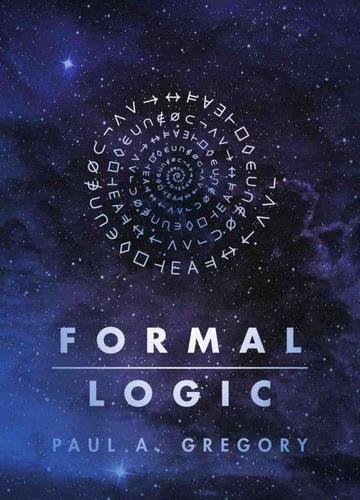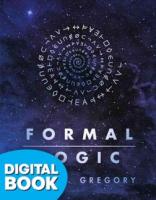Formal Logic is an undergraduate text suitable for introductory, intermediate, and advanced courses in symbolic logic. The book’s nine chapters offer thorough coverage of truth-functional and quantificational logic, as well as the basics of more advanced topics such as set theory and modal logic. Complex ideas are explained in plain language that doesn’t presuppose any background in logic or mathematics, and derivation strategies are illustrated with numerous examples. Translations, tables, trees, natural deduction, and simple meta-proofs are taught through over 400 exercises. A companion website offers supplemental practice software and tutorial videos.
I: Informal Notions
1: Informal Introduction
1.2 Arguments, Forms, and Truth Values
1.3 Deductive Criteria 1.3.1Quirky Cases of Deductive Validity 1.4 Inductive Criteria
1.5 Other Deductive Properties
1.6 Exercises
1.7 Chapter Glossary
II: Truth-Functional Logic
2: The Language S
2.1.2 Negation—It is not the case that…
2.1.3 Conjunction—Both…and---
2.1.4 Disjunction—Either…or---
2.1.5 Material Conditional—If …, then---
2.1.6 Material Biconditional—…if and only if---
2.1.7 Conditionals and Non-Truth-Functionality 2.2 Some Technical Bits 2.2.1 Object Language and Metalanguage
2.2.2 Use and Mention
2.2.3 Metavariables
2.2.4 Syntax and Semantics
2.3 The Syntax of S
2.3.1 Defining the Language
2.3.2 Syntactic Concepts and Conventions
2.3.3 Exercises 2.4 Alternate Symbols and Other Choices
2.5 Chapter Glossary
3: Formal Semantics for S
3.1 Truth Value Assignments and Truth Tables3.2 Semantic Properties of Individual Wffs
3.2.1 Exercises 3.3 Semantic Properties of Sets of Wffs
3.3.1 Exercises 3.4 Semantic Properties, Their Interrelations, and Simple Metalogic
3.4.1 Exercises 3.5 Truth Trees
3.5.1 Tests with Truth Trees
3.5.2 Exercises 3.6 Chapter Glossary
4: SD: Natural Deduction in S
4.1 The Basic Idea4.1.1 Reiteration
4.1.2 Wedge Rules
4.1.3 Arrow Rules
4.1.4 Hook Rules
4.1.5 Vee Rules
4.1.6 Double Arrow Rules
4.1.7 Exercises 4.2 Derivations: Strategies and Notes
4.3 Proof Theory in SD 4.3.1 Exercises 4.4 SDE, an Extension to SD 4.4.1 The Inference Rules of SDE
4.4.2 Exercises
4.4.3 The Replacement Rules of SDE
4.4.4 Exercises 4.5 Chapter Glossary
III: Quantificational Logic
5: The Language P
5.1.2 Predicates and Singular Terms
5.1.3 Predicate Letters and Individual Constants in P
5.1.4 Pronouns and Quantifiers
5.1.5 Variables and Quantifiers in P 5.2 The Syntax of P 5.2.1 Defining the Language
5.2.2 Syntactic Concepts and Conventions
5.2.3 Exercises 5.3 Simple Symbolizations 5.3.1 Non-categorical Claims
5.3.2 Exercises
5.3.3 Categorical Claims
5.3.4 Exercises 5.4 Complex Symbolizations 5.4.1 Basics of Overlapping Quantifiers
5.4.2 Exercises
5.4.3 Identity, Numerical Quantification, and Definite Descriptions
5.4.4 Exercises 5.5 Chapter Glossary
6: Formal Semantics for P
6.1 Semantics and Interpretations 6.1.1 Basics of Interpretations6.1.2 Interlude: A Little Bit of Set Theory
6.1.3 Formal Interpretation of P
6.1.4 Constructing Interpretations 6.2 Semantic Properties of Individual Wffs 6.2.1 Exercises 6.3 Semantic Properties of Sets of Wffs 6.3.1 Exercises 6.4 Quantifier Scope and Distribution 6.4.1 Exercises 6.5 Properties of Relations 6.5.1 Exercises 6.6 Chapter Glossary
7: PD: Natural Deduction in P
7.1 Derivation Rules for the Quantifiers 7.1.1 Universal Elimination7.1.2 Existential Introduction
7.1.3 Universal Introduction
7.1.4 Existential Elimination
7.1.5 Exercises 7.2 Derivations: Strategies and Notes
7.3 Proof Theory in PD 7.3.1 Exercises 7.4 PDE, an Extension to PD 7.4.1 Quantifier Negation
7.4.2 Exercises 7.4 Chapter Glossary
IV: Advanced Topics
8: Basic Set Theory, Paradox, and Infinity
8.2 Russell’s Paradox
8.3 The Axiom Schema of Separation
8.4 Subset, Intersection, Union, Difference 8.4.1 Exercises 8.5 Pairs, Ordered Pairs, Power Sets, Relations, and Functions
8.6 Infinite Sets and Cantor’s Proof 8.6.1 Exercises 8.7 Chapter Glossary
9: Modal Logic
9.1 Necessity, Possibility, and Impossibility 9.1.1 Modalities9.1.2 Logical, Metaphysical, Physical
9.1.3 Possible Worlds 9.2 The Language S 9.2.1 The Syntax of S
9.2.2 Exercises 9.3 Basic Possible Worlds Semantics for S 9.3.1 Semantic Properties of Wffs and Sets of Wffs
9.3.2 Exercises
9.3.3 Possible Worlds and Trees
9.3.4 Exercises 9.4 Natural Deduction in S 9.4.1 System K
9.4.2 System D
9.4.3 System T
9.4.4 System B
9.4.5 System S4
9.4.6 System S5
9.4.7 Relations Between Modal Systems
9.4.8 Exercises 9.5 Chapter Glossary
V: Appendices
A: Answers to Exercises
B: Glossary
C: Truth Tables, Tree Rules, and Derivation Rules
C.2 Truth Tree Rules for S
C.3 The Derivation System SD
C.4 The Derivation System SDE
C.5 The Derivation System PD
“Formal Logic is clear, accessible, and intuitive, but it is also precise, explicit, and thorough. Complex and often confusing concepts are rolled out in a no-nonsense and direct manner with funny and demystifying terminology and helpful analogies. It's a pedagogical gem.” — Mary Kate McGowan, Wellesley College
“This is an excellent introductory text in symbolic logic. It is accessible, with clear and concise explanations of key concepts, along with many helpful examples and practice problems, but also rigorous enough to prepare students for a second course in logic; indeed, I do not know of any book that better combines these virtues. I am looking forward to using Formal Logic in my courses.” — Kevin Morris, Tulane University
“This book makes the ideas of sentential logic, predicate logic, and formal proof easily accessible by getting directly to the point of each in natural, non-technical language. It is concise while never hurried. It gets the details right, not by focusing on them as details, but through clear insight into why they are as they are.” — Colin McLarty, Case Western Reserve University
“Paul Gregory’s Formal Logic is worth careful consideration for anyone adopting a new logic text. The inclusion of chapters on set theory and modal logic makes it a valuable resource for students looking to go beyond the standard introduction to logic.” — Michael Hicks, Miami University


